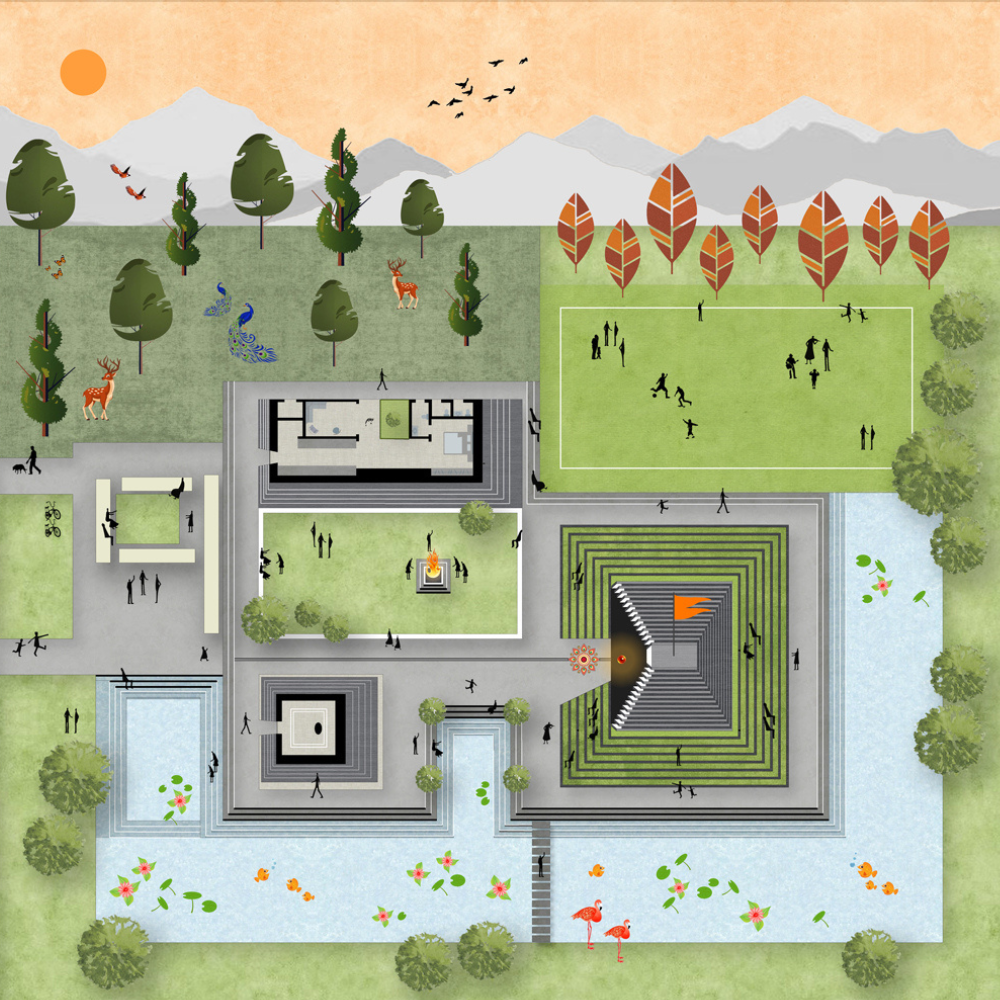Attention on Religious Spaces: The Temple of Steps in Andhra Pradesh’s Nandyal
Introduction
The Balaji Temple (Temple of steps), settled among Strand and Unfriendly farm in nandyal, expected to various socio- educational knowledgeable with environmental undercurrents groundwater boost instigated by guiding water overflow to a coastal ‘kund’ planned as a social space approaching traditional ghats. Stimulated by 10th time temples, it landscapes Balaji & Varahaswamy shrines and a Pushkarini. Far away soursed black sandstone lumps form the temples essential, with corbelled profiles integrating earth and silver-plating for usual Colling. These outlines range into ladders opening the water, ringing India’s architectural legacy seen in Banaras ghats.

Temple of Steps is made out of Black Limestone Ziggurats in Nandyal
The Mumbai founded firm run by sameep padora, has an accomplished a temple designed for the peoples of towns about the Indian town of nandyal. The development embraces two graves to Balaji and Varahaswamy in the method of black limestone ziggurats. In the interim the similar material has been used for a detached building that holds the rector’s quarters and a prasad pledge for contributions. a tank, discussed to as a ‘pushkarini’, environments the temple with a low body of water.
As the Development in positioned in a fussiness dry area. The designers say that the natural Policy for the scheme commenced with the position of carrying groundwater of the side in the dry landscape of nandyal, the main worry was to offer a planetary which would espouse the socio-cultural outlooks of a temple with the environmental context and subtleties of and around the site,’ explains. the instant situation of strand and chilly farmhouses in the area were fed by a usual seaway organization which had desiccated up.
therefore, water overflow from close mineral excavations was led to a lowland renew quarry or ‘kund’. the plan squad then imaginary the rows of this location as a social space, parallel to that of an old-style ‘gnat’ — a flying of stepladders foremost unhappy to a body of water. ‘this cooperation of land-living and water with steps is a momentous part of India’s architectural heritage as is seen in the ghats of the early city of benaras (varanasi)’, the planners stay.
the arrangement of the Balaji temple, also identified as the ‘temple of steps’, was built on a 10th century project for the same idol in the city of tirupati, which includes the same memorials. the edifice process usages close by accessible black limestone chunks to form the main body of the temple. in the meantime, earth and establishing has been combined in the minor semi of the assemblies to deliver defense in contradiction of warmness.

Project description
Project: Balaji Temple (Temple of Steps)
Customer: Anushree Jindal, JSW Cement Ltd
Place: Nandyal
Area: 2.5 properties
Principal architect: Sameep Padora
Design squad: Sanjana Purohit, Vami Sheth, Aparna Dhareshwar and Kunal Sharma
The short-lived was to project a temple for the peoples of township about Nandyal. In the dry terrain of Nandyal, the main worry was to deliver a space which would marry the socio-cultural opportunities of a temple with the environmental outline and undercurrents of and around the site. The instant situation of Cotton and frigid farms in the district were fed by a normal canal system which had desiccated up. The natural method for the temple thus, began with renewing of groundwater. Water excess from the sandstone quarries was led to a low-lying recharge pit or ‘kund’: the banks of which was illusory as a social space, in the method of a traditional ghat a flight of steps tops down to a water-body. This negotiation of land and water with steps is an important part of India’s architectural legacy as is got in the ghats of the antique urban of Benaras.
The development of the temple itself was founded on a 10th period temple for the same idol at Tirupati in Southern India and similarly includes the Balaji & Varahaswamy shrines and a Pushkarini.
The building process uses nearby accessible black mineral slabs corbelled to form the main body of the temple. The same corbelled profile also comprises soil and founding in the slight half of the temple body to barricade against the fever and lastly this stone corbelling goes curved on a ghat i.e. the steps that charge the water. The Balaji temple in Nandyal learns and cuttings the long custom of the temple typology in India.
The architectural theorist Andrew Benjamin emblazoned that each act of project was an act of duplication, and that style is about travelling what not to repeat. This edifice too repeats or matches positive tropes of the Hindu temple so that it is decipherable as a shrine yet it doesn’t repeat those tropes but slightly breaks them down to integral parts to then again renovate it.
One airs at the connection of the temple and the kund as a inconsistent yet opposite one of binary converses. It is a relationship among a solid and a void, amid reaching out to the sky and successful deep into the crushed about deposit and mine.
Conclusion
Balaji Temple (Temple of Steps), an architectural plan intended by Sameep Padora & Connections the instant background was of Fiber farms in the district, which were fed by a normal canal scheme & had dry up. The biological policy for the temple thus began with the refreshing of groundwater. Water run-off from the mineral mines led to a low-lying boost pit or ‘kund’ the banks of which were unreal as a common interstellar.
About the Author
Article has been written by Urmi













